Wikipedia:Picture of the day/December 2023
|
Featured picture tools: |
These featured pictures, as scheduled below, appeared as the picture of the day (POTD) on the English Wikipedia's Main Page in December 2023. Individual sections for each day on this page can be linked to with the day number as the anchor name (e.g. [[Wikipedia:Picture of the day/December 2023#1]] for December 1).
You can add an automatically updating POTD template to your user page using {{Pic of the day}} (version with blurb) or {{POTD}} (version without blurb). For instructions on how to make custom POTD layouts, see Wikipedia:Picture of the day.
December 1
|
The Arecibo Telescope was a 305-meter-diameter (1,000 ft) spherical-reflector radio telescope built into a natural sinkhole at the Arecibo Observatory located near Arecibo, Puerto Rico. A cable-mount steerable receiver and several radar transmitters for emitting signals were mounted 150 meters (492 ft) above the parabolic antenna. Completed in November 1963, the Arecibo Telescope was the world's largest single-aperture telescope for 53 years, until it was surpassed in July 2016 by the Five-hundred-meter Aperture Spherical Telescope (FAST) in Guizhou, China. Following a long period of declining maintenance exacerbated by Hurricane Maria and two earthquakes, the Arecibo Telescope's receiver cables suffered a catastrophic failure that culminated in the collapse of the receiver platform at around 6:55 a.m. AST (10:55 UTC) on December 1, 2020, as captured in this video. The collapse of the receiver structure and cables onto the dish caused extensive additional damage, and ultimately resulted in the decision to demolish the remaining structure in 2022. Video credit: National Science Foundation
Recently featured: |
December 2

|
|
The coronation of Napoleon was the crowning of Napoleon and his wife Joséphine as Emperor and Empress of the French, which took place on December 2, 1804, at Notre-Dame cathedral in Paris. It took the format of a sacred ceremony, in the presence of Pope Pius VII. Preparations for the coronation began in May 1804, when the Sénat conservateur voted to change the constitution to vest the French First Republic's government in an emperor, a move ratified in a constitutional referendum in November 1804. Napoleon's motivations for being crowned included a desire for prestige in international royalist and Catholic circles and to lay the foundation for a future dynasty. The event is also regarded by historians as a propaganda exercise. Napoleon's coronation was markedly different from those of the French monarchy and brought together various rites and customs, incorporating ceremonies of Carolingian tradition, the ancien régime and the French Revolution, with a highly luxurious presentation. This large oil-on-canvas painting, titled The Coronation of Napoleon, measures 6.21 m × 9.79 m (20 ft 4 in × 32 ft 1 in) and was painted by Jacques-Louis David (assisted by his student Georges Rouget) between 1805 and 1807, depicting the moment of Joséphine's crowning by Napoleon. The painting now hangs in the Louvre in Paris. Painting credit: Jacques-Louis David and Georges Rouget
Recently featured: |
December 3

|
|
Mullus barbatus, commonly known as the red mullet, is a species of goatfish found in the Mediterranean Sea, the Black Sea and the northeastern and central eastern Atlantic Ocean, where its range extends from Scandinavia southwards to Senegal, including Canary Islands, Azores and Madeira. It is a demersal fish and occurs at depths ranging from 10 to 328 m (30 to 1,000 ft) over muddy, sandy or gravel bottoms. It can grow to a standard length of 30 cm (12 in), but it is more commonly around 15 cm (6 in) long. Its snout is short and steep and there are no spines on the operculum. The upper jaw is toothless, but there are teeth on the roof of the mouth and on the lower jaw. A pair of moderately long barbels on the chin do not exceed the pectoral fins in length. This fish is rose-pink, without distinctive markings on its fins. This M. barbatus individual was photographed in the Arrábida Natural Park, Portugal. Photograph credit: Diego Delso
Recently featured: |
December 4

|
|
Laodicea on the Lycus was an ancient city in Asia Minor, situated on a hill above the river Lycus. It was located in the Hellenistic regions of Caria and Lydia, which later became the Roman Province of Phrygia Pacatiana, close to the modern city of Denizli in Turkey. Laodicea was built on the site of an earlier pre-Hellenistic settlement, and was founded by Antiochus II Theos, the king of the Seleucid Empire from 261 to 253 BC, in honour of his wife Laodice, together with several other cities of the same name. Laodicea became a wealthy city, and was later controlled by the Roman and Byzantine empires. The city had a large Jewish population, dating from the time of Antiochus the Great, who transported 2000 Jewish families there from Babylonia. It also became an early seat of Christianity with a bishopric. The Epistle to the Colossians mentions Laodicea as one of the communities of concern for Paul the Apostle. The city was destroyed in an earthquake in around AD 60, and subsequently rebuilt. It was eventually destroyed during the invasions of the Turks and Mongols during the second millennium, and is now a ruin. This photograph taken in 2020 shows the remains of a colonnaded Laodicean street. Photograph credit: Alexander Savin
Recently featured: |
December 5

|
Columbidae is a bird family consisting of doves and pigeons. In English, the smaller species tend to be called doves and the larger ones pigeons, but this distinction is not always consistent and scientifically there is no separation between them. Pigeons and doves are distributed everywhere on Earth, except for the driest areas of the Sahara, Antarctica and its surrounding islands, and the high Arctic. The family has adapted to most of the habitats available on the planet. There is a considerable variation in size between species, ranging in length from 15 to 75 cm (6 to 30 in), and in weight from 30 g (1 oz) to above 2 kg (4 lb). Overall, the anatomy of Columbidae is characterized by short legs, short bills with a fleshy beak, and small heads on large, compact bodies. The wings are large, and have eleven primary feathers; they have strong wing muscles and are among the strongest fliers of all birds. They primarily feed on seeds, fruits, and plants. This red-eyed dove (Streptopelia semitorquata) was photographed on the Zambezi in Zimbabwe, near Kazungula Bridge. Photograph credit: Charles J. Sharp
Recently featured: |
December 6

|
Keke Rosberg (born 6 December 1948) is a Finnish former racing driver and the winner of the 1982 Formula One World Championship. He was the first Formula One driver from Finland to win the championship. Rosberg began his Formula One career in 1978 and he drove for a number of different teams before signing for Williams in 1982. After four seasons there, he spent his final season with McLaren before retiring in 1986. Rosberg's son Nico won the 2016 Formula One World Championship. This photograph, from the archives of the Dutch photograph press agency Anefo, shows Rosberg at the 1982 Dutch Grand Prix. Photograph credit: Hans van Dijk; restored by Adam Cuerden
Recently featured: |
December 7
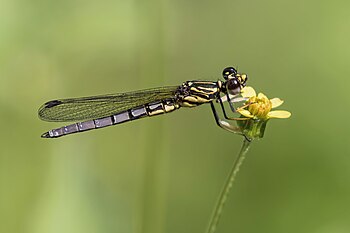
|
Platycypha caligata, commonly known as the dancing jewel, is a species of damselfly in the family Chlorocyphidae. It is found in eastern, central and southern Africa from Ethiopia to Angola and South Africa. Its natural habitats include shady parts of subtropical or tropical streams and rivers in forest, woodland, savanna, shrubland, and the shorelines of lakes. Males perform remarkable territorial and courtship displays which include flashing their brightly coloured legs with flattened tibiae and waving their abdomens. This male dancing jewel, with a length of around 35 mm, was photographed near Victoria Falls in Zambia. Photograph credit: Charles J. Sharp
Recently featured: |
December 8

|
|
Mount Api is a limestone mountain located in Gunung Mulu National Park in Sarawak, Malaysia. It is part of the same formation as Mount Benarat and Mount Buda. Mount Api is notable for its striking limestone karst formations, commonly known as "the pinnacles". The mountain hosts many caves, with passages linking to the massive Clearwater Cave system. It features a great diversity of pitcher plants, with at least eight different species recorded on the mountain. This 2019 photograph shows the karst pinnacles near the peak of Mount Api. Photograph credit: Nur Nafis Naim
Recently featured: |
December 9
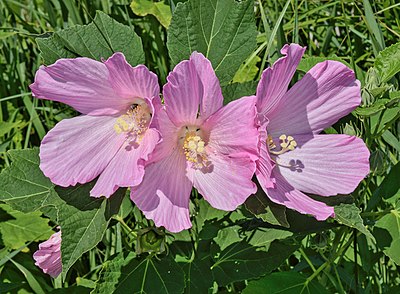
|
Hibiscus moscheutos, commonly known by various names including rose mallow and swamp rose-mallow, is a species of flowering plant in the family Malvaceae. It is a cold-hardy perennial wetland plant that can grow in large colonies. The hirsute leaves are of variable morphology, but are commonly deltoidal in shape with up to three lobes. It is found in wetlands and along the riverine systems of the eastern United States from Texas to the Atlantic states, its territory extending northward to southern Ontario, Canada. It is a tall plant, with a height of 1.5 to 2.5 meters (4.9 to 8.2 ft) and flowers up to 20 centimeters (7.9 in) across. Petal colors range from pure white through various pinks to red, and most have an eye of deep maroon. These pink H. moscheutos flowers were photographed in Point Pelee National Park in Ontario. Photograph credit: The Cosmonaut
Recently featured: |
December 10
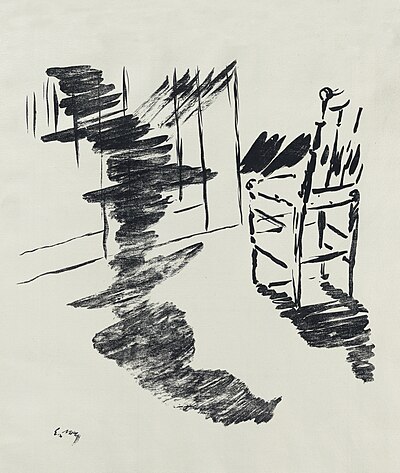
|
"The Raven" is a narrative poem by the American writer Edgar Allan Poe. The poem describes a narrator who is half asleep, poring over ancient books at midnight on a dreary winter night. He hears a tapping sound, and finds a raven at the window, which flies into his room and perches on a bust of Athena. The narrator asks the bird a series of questions, to which the bird replies only "nevermore". Eventually, the narrator falls into despair and ends with his final admission that his soul is trapped beneath the raven's shadow and shall be lifted "nevermore". Originally published in 1845, the poem was widely popular but did not bring Poe much financial success. It has influenced many modern works and is referenced throughout popular culture. This lithographic illustration by Édouard Manet is the last in a set of four plates that depict different stages in "The Raven". Describing this plate, the art historian James H. Rubin wrote: "In the fourth plate, shadow has itself taken on life, becoming the most prominent form. At its bottom it resembles that cast by the bird perched upon the bust, but then in much freer strokes it becomes a dense vapour rising and trailing into oblivion." Illustration credit: Édouard Manet; restored by Adam Cuerden
Recently featured: |
December 11

|
|
Tribhuvan (1906–1955) was King of Nepal from 11 December 1911 until his death. Born in the Nepalese capital, Kathmandu, he ascended to the throne at the age of five, upon the death of his father Prithvi Bir Bikram Shah, and was crowned in 1913 with his mother acting as regent. At the time of his crowning, the position of monarch was largely ceremonial, with the real governing power residing with the Rana dynasty. During World War I, the Ranas wanted Nepal to join the war in support of the United Kingdom, while the royal family wished to remain neutral. Eventually, Prime Minister Chandra Shumsher Jung Bahadur Rana pressured the young king while threatening his mother, forcing him to order the troops to war. This photograph, held by Madan Puraskar Pustakalaya, was taken at Tribhuvan's coronation in 1911. Photograph credit: unknown; restored by CAPTAIN MEDUSA
Recently featured: |
December 12

|
The pink cockatoo (Cacatua leadbeateri) is a medium-sized cockatoo that inhabits arid and semi-arid inland areas across Australia, with the exception of the north east. The bird has a soft-textured white and salmon-pink plumage and large, bright red and yellow crest. The sexes are quite similar, although males are usually bigger while the female has a broader yellow stripe on the crest and develops a red eye when mature. The pink cockatoo is usually found in pairs or small groups, and feeds both on the ground and in trees. It is listed as an endangered species by the Australian government. Formerly known as Major Mitchell's cockatoo, after the explorer Thomas Mitchell, the species was officially renamed the pink cockatoo in 2023 by BirdLife Australia in light of Mitchell's involvement in the massacre of Aboriginal people at Mount Dispersion, as well as a general trend to make Australian species names more culturally inclusive. This pink cockatoo with a raised crest was photographed near Mount Grenfell in New South Wales. Photograph credit: John Harrison
Recently featured: |
December 13

|
|
A Bézier curve is a parametric curve used in computer graphics and related fields. Related to the Bernstein polynomial, it is named after Pierre Bézier, who used it in the 1960s for designing curves for the bodywork of Renault cars. Other uses include the design of computer fonts and animation. Bézier curves can be combined to form a Bézier spline, or generalized to higher dimensions to form Bézier surfaces. This animation shows a linear Bézier curve, the simplest type, generating a straight line between the points P0 and P1. This is equivalent to linear interpolation. Animation credit: Phil Tregoning
Recently featured: |
December 14

|
|
The raspberry is the edible fruit of a multitude of plant species in the genus Rubus of the rose family, most of which are in the subgenus Idaeobatus. The name also applies to the plant itself. Raspberry plants are perennial with woody stems. It is an aggregate fruit, developing from the numerous distinct carpels of a single flower. Originally occurring in East Asia, the raspberry is now cultivated across northern Europe and North America and is eaten in a variety of ways including as a whole fruit and in preserves, cakes, ice cream and liqueurs. Raspberries are a rich source of vitamin C, manganese, and dietary fiber. Photograph credit: Ivar Leidus
Recently featured: |
December 15

|
Tim Peake (born 1972) is a British military officer and astronaut. On 15 December 2015, he embarked on a mission to the International Space Station (ISS), becoming the second astronaut wearing the British flag in space, after Helen Sharman. After graduating from Royal Military Academy Sandhurst, Peake served in various military roles between 1992 and 2009, accumulating 3,000 flying hours. He was then selected to join the European Space Agency's astronaut corps where he was trained and took part in missions such as in the Aquarius Reef Base, in which he spent twelve days underwater. During his mission to the ISS, Peake supported a spacewalk by two American astronauts before carrying out a spacewalk himself to replace a faulty sequential shunt unit on the station's solar arrays. He also participated in several UK events from space, such as delivering a new year's message broadcast on the BBC and remotely presenting an award to singer Adele in the Brit Awards 2016. Peake returned to Earth in June 2016, having completed 3,000 orbits of Earth, and retired from active service in 2023. This official NASA photograph of Peake was taken in 2013. Photograph credit: Robert Markowitz
Recently featured: |
December 16

|
|
The common cuttlefish (Sepia officinalis) is one of the largest and best-known cuttlefish species. It is native to the Mediterranean Sea, North Sea, and Baltic Sea, with some subspecies proposed in South Africa. It lives on sand and mud seabeds and can tolerate brackish water. The common cuttlefish is a migratory species, spending the summer and spring inshore for spawning and then moving to depths of 100 to 200 metres (330 to 660 ft) during autumn and winter. It has a mantle of up to 49 centimetres (19 in), with a mass of 4 kilograms (8.8 lb). Cuttlefish have strong camouflaging abilities, enabled by a variety of specialized cells: pigmented chromatophore organs, light-scattering leucophores, and structurally reflecting iridophores in their skin. This common cuttlefish was photographed in Arrábida Natural Park, Portugal. Photograph credit: Diego Delso
Recently featured: |
December 17

|
|
The Wright Flyer, also known as the Kitty Hawk, made the first sustained flight by a manned heavier-than-air powered and controlled aircraft – an airplane – on December 17, 1903. Invented and flown by the Wright brothers, it marked the beginning of the pioneer era of aviation. The Wright Flyer is a single-place biplane design with anhedral (drooping) wings, front double elevator and rear double rudder. It used a 12-horsepower (9-kilowatt) gasoline engine powering two pusher propellers. Employing "wing warping", it was relatively unstable and very difficult to fly. The Wright brothers flew it four times in a location south of Kitty Hawk, North Carolina. The airplane flew 852 feet (260 m) on its fourth and final flight, but was damaged on landing, and minutes later was wrecked when powerful gusts blew it over. The aircraft never flew again but was shipped home and subsequently restored by Orville Wright. It was housed in the Science Museum in London from 1928 to 1948, and is now exhibited at the National Air and Space Museum in Washington, D.C. This photograph, taken by John T. Daniels, a local member of the United States Life-Saving Service, shows the Wright Flyer seconds into its first flight in 1903. Photograph credit: John T. Daniels; restored by Lise Broer
Recently featured: |
December 18

|
|
Laguna Miñiques is a lake in northern Chile. It lies at the foot of the volcano Cerro Miscanti, south of Laguna Miscanti, from which it receives inflow by seepage. The two lakes are separated by a lava flow. Like Miscanti and the nearby Laguna Lejía, Miñiques is a fault-bound lake and has brackish waters. A popular tourist destination, it is part of the Los Flamencos National Reserve, and is home to wildlife including the cladocerans Alona pulchella and Daphnia, the copepod Boeckella poopoensis, and unidentified species of Cyclopoida. This panoramic photograph of Laguna Miñiques was taken in February 2016. Photograph credit: Diego Delso
Recently featured: |
December 19
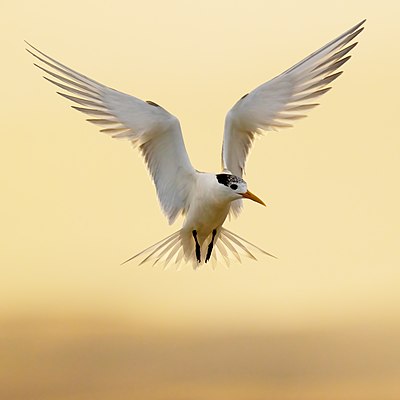
|
The greater crested tern (Thalasseus bergii) is a seabird in the tern family, which nests in dense colonies on coastlines and islands in the tropical and subtropical Old World. Its five subspecies breed in the area from South Africa around the Indian Ocean to the central Pacific and Australia, all populations dispersing widely from the breeding range after nesting. The greater crested tern has grey upperparts, white underparts, a yellow bill, and a shaggy black crest which recedes in winter. Like all members of the genus Thalasseus, it feeds by plunge diving for fish, usually in marine environments; the male offers fish to the female as part of the courtship ritual. This is an adaptable species which has learned to follow fishing boats for jettisoned bycatch, and to utilise unusual nest sites such as the roofs of buildings and artificial islands in salt pans and sewage works. Its eggs and young are taken by gulls and ibises, and human activities such as fishing, shooting and egg harvesting have caused local population declines. There are no global conservation concerns for this bird, which has a stable total population of more than 500,000 individuals. This greater crested tern in flight was photographed at Mortimer Bay in Tasmania, Australia. Photograph credit: John Harrison
Recently featured: |
December 20

|
Walter Q. Gresham (1832–1895) was an American attorney, jurist, statesman, and politician who served in the cabinets of presidents Chester A. Arthur and Grover Cleveland. He was the 31st United States postmaster general under Arthur from 1883 to 1884 and briefly then the 35th secretary of the treasury from September to October 1884 before resigning to become a federal judge. He was twice a candidate for the Republican nomination for president in 1884 and 1888 before leaving the party to support Cleveland in the 1892 election. He joined Cleveland's second cabinet as the 33rd U.S. secretary of state from 1893 until his death in 1895. Gresham served as a federal judge on the Court of Appeals for the Seventh Circuit, the circuit courts for the Seventh Circuit, and the district court for the District of Indiana. This line engraving of Gresham was produced around 1902 by the Department of the Treasury's Bureau of Engraving and Printing, as part of a presentation album of the first 42 secretaries of the treasury. Engraving credit: Bureau of Engraving and Printing; restored by Andrew Shiva
Recently featured: |
December 21
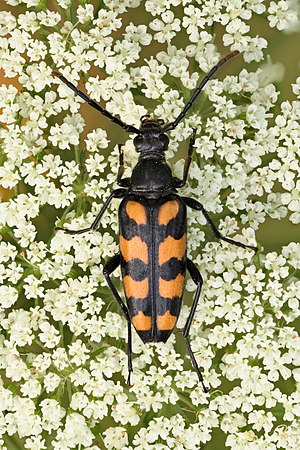
|
Leptura quadrifasciata, the four-banded longhorn beetle, is a species of beetle in the family Cerambycidae. It is found throughout the northern and central Palaearctic region. The species is distributed in northern and central regions of Europe and Asia. It is particularly common in Scandinavia, Finland and Great Britain, and typically seen during the summer months. The larvae make meandering galleries in various trees, including oak, beech, birch, willow, alder, elder and spruce – typically in dead and decaying wood, with a preference for damp areas. Adult beetles are 11 to 20 millimetres (0.43 to 0.79 in) long, black with four more or less continuous transverse yellow bands. In extreme cases the elytra may be almost entirely black. The life cycle of the species lasts two or three years. This L. quadrifasciata female was photographed on wild carrot flowers near Keila, Estonia. Photograph credit: Ivar Leidus
Recently featured: |
December 22

|
The Laughing Cavalier is an oil-on-canvas portrait by the Dutch Golden Age painter Frans Hals, completed in 1624. The title is an invention of the Victorian public and press, dating from its exhibition in the opening display at the Bethnal Green Museum from 1872 to 1875, just after its arrival in England. The Laughing Cavalier was described by art historian Seymour Slive as "one of the most brilliant of all Baroque portraits" and has been used in several derivative works, such as the logo of McEwan's beer, which depicts a modified version of the cavalier enjoying a glass of the drink. The painting is now housed in the Wallace Collection in London. Painting credit: Frans Hals
Recently featured: |
December 23
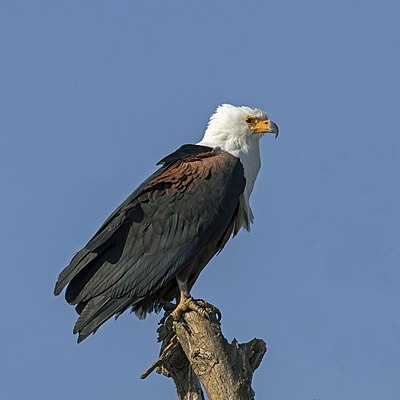
|
The African fish eagle (Icthyophaga vocifer) is a large species of eagle found throughout sub-Saharan Africa, wherever large bodies of open water with an abundant food supply occur. It is a generalist species, requiring only open water with sufficient prey and a good perch, as evidenced by the number of habitat types in which this species may be found. Habitats include grasslands, swamps, marshes, tropical rainforests and fynbos, as well as freshwater lakes, reservoirs, and rivers. Some are also found close to the coast, both at the mouths of rivers or lagoons and on desert-bordering coastline. The African fish eagle is a large bird, with females having a mass of 3.2 to 3.6 kg (7.1 to 7.9 lb), somewhat larger than the male, at 2.0 to 2.5 kg (4.4 to 5.5 lb). It breeds during the dry season, when water levels are low and it is believed to be a monogamous species. It is the national bird of Malawi, Namibia, Zambia, and Zimbabwe. This African fish eagle was photographed at Lake Ziway in Ethiopia. Photograph credit: Charles J. Sharp
Recently featured: |
December 24

|
|
Street football, or street soccer, is an informal variation on the game of association football, typically played in outdoor urban settings such as streets, playgrounds and car parks. The term encompasses a variety of different formats, which do not necessarily follow the requirements of a formal game of football, such as a large field, field markings, goal apparatus and corner flags, eleven players per team, or match officials (referee and assistant referees). Street football is often played as a pick-up game, without fixed timing and with players joining and leaving at any point. Many international professional players learned to play football on the street, including Diego Maradona, Johan Cruyff, Pelé, Giuseppe Meazza, Eamon Dunphy, Eusébio, Dejan Savićević, and Cristiano Ronaldo. This 2017 photograph shows boys playing street football on al-Mu'izz Street in Cairo, Egypt, by the exterior wall of the al-Hakim Mosque. Photograph credit: Mohamed Hozyen Ahmed; edited by Bammesk
Recently featured: |
December 25
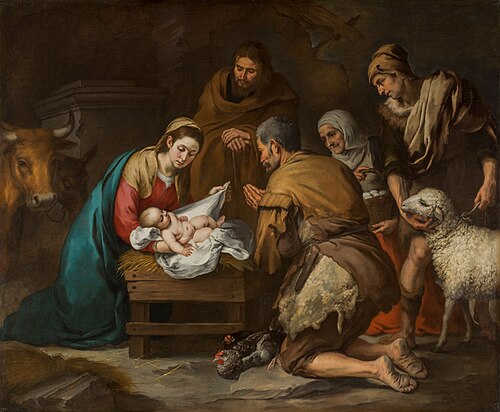
|
|
The Adoration of the Shepherds is an episode in the story of the Nativity of Jesus in which shepherds are near witnesses to Jesus's birth in Bethlehem. It is based on the account in the Gospel of Luke and follows the Annunciation to the Shepherds, in which the shepherds are summoned by an angel to the scene of the birth. Like the episode preceding it, the Adoration of the Shepherds is a common subject in art, where it is often combined with the Adoration of the Magi. Depictions of the shepherds' adoration of the Christ Child as a subject distinct from that of the biblical Magi began to appear around the 15th century in artworks and altarpieces in the western Christian world. The shepherds are sometimes shown presenting simpler gifts than those of the Magi, such as lambs. This Adoration of the Shepherds is an oil-on-canvas painting by Bartolomé Esteban Murillo, a Spanish Baroque artist. Painted around 1650, the work is now in the Museo del Prado in Madrid. Painting credit: Bartolomé Esteban Murillo
Recently featured: |
December 26

|
|
The Sonoma chipmunk (Neotamias sonomae) is a species of rodent in the squirrel family, Sciuridae. It is endemic to the U.S. state of California, north of San Francisco Bay, with most of its range within Sonoma County and Marin County. The species is found in areas of coniferous forests such as sticky laurel and ponderosa pine, as well as in chaparral, particularly sagebrush plains. Its range includes elevations from sea level to 1800 meters (5,900 ft). The chipmunk typically lives on the ground and makes burrows, but can also climb and may make nests in trees. Like other members of the Neotamias genus, it has two premolars. This Sonoma chipmunk was photographed in Samuel P. Taylor State Park in Marin County, California. Photograph credit: Frank Schulenburg
Recently featured: |
December 27
|
The Dover Boys at Pimento University is a 1942 Merrie Melodies cartoon directed by Chuck Jones and distributed by Warner Bros. Pictures. A parody of the Rover Boys, a popular juvenile fiction book series of the early 20th century, it was one of the first cartoons to make extensive use of limited animation, as well as other techniques that would only be more broadly popularized in the 1950s. Michael Barrier, an animation historian, wrote: "Is The Dover Boys the first 'modern' cartoon? ... Chuck Jones stylized the animation in this cartoon in a way that anticipated what several consciously modern studios like UPA would be doing a decade later." The Dover Boys was voted by animation professionals as number 49 in The 50 Greatest Cartoons, published in 1994. It was released on September 19, 1942, and has a running time of 8 minutes, 56 seconds. Film credit: Chuck Jones
Recently featured: |
December 28

|
|
Bell Island is a small island in the south-west of the Franz Josef Land archipelago in Arkhangelsk Oblast, Russia. Located in the Arctic Ocean, the island was named by the English explorer Benjamin Leigh Smith for its bell-shaped mountain which rises steeply from the island's southern coast. The island was the first among the Franz Josef archipelago to be visited by Leigh Smith in an expedition he undertook in 1880. In a second expedition to the islands in 1881, Leigh Smith built the wooden Eira lodge on the north side of the island which he used to winter. The lodge stands to this day. The island was later visited by the Svyataya Anna of the ill-fated Brusilov expedition in 1914. This view shows Bell Island in 2017 with Eira lodge in the foreground. Photograph credit: Timinilya
Recently featured: |
December 29

|
The northern flicker (Colaptes auratus) is a medium-sized bird of the woodpecker family, Picidae. It is native to most of North America, parts of Central America, Cuba, and the Cayman Islands. Adults of this species are brown with black bars on the back and wings, with a mid- to large-sized northern flicker measuring 28 to 36 cm (11 to 14 in) in length and 42 to 54 cm (17 to 21 in) in wingspan. Its body mass can vary from 86 to 167 grams (3.0 to 5.9 oz). Northern flickers are partial migrants, with those that do migrate beginning their spring migration in early April and making their return between September and October. Individuals that breed farther north travel greater distances than their migratory southern conspecifics, often resulting in the convergence of northern and southern populations at wintering sites. This male northern flicker was photographed looking out from a nesting hole in a tree in Central Park, New York City. Photograph credit: Rhododendrites
Recently featured: |
December 30

|
Diamond is a solid form of carbon with its atoms arranged in a crystal structure known as diamond cubic. It is metastable at standard temperature and pressure, converting to the chemically stable form graphite under those conditions but at a negligible rate. Diamond has the highest hardness and thermal conductivity of any natural material, properties that are useful in major industrial applications such as cutting and polishing tools. In addition to its industrial uses, diamond is much sought-after as a gemstone for use in jewelry. Most natural diamonds were formed between 1 billion and 3.5 billion years ago, at depths between 150 to 250 kilometres (93 to 155 mi) in the Earth's mantle. They were then carried to the surface more recently in volcanic eruptions and deposited in igneous rocks known as kimberlites and lamproites. This photograph shows the cathodoluminescence of a round-cut diamond, taken with the use of a scanning electron microscope. The image has a field of view of 3.45 millimetres (0.136 in). Photograph credit: Pavel Somov
Recently featured: |
December 31

|
Philip IV (1605–1665) was King of Spain from 1621 until his death, and also King of Portugal from 1621 to 1640. He was a member of the House of Habsburg and the eldest son of Philip III. Much of Philip IV's reign was dominated by the Thirty Years' War, and despite some successes his legacy is characterized by political and military adversity and the ongoing 17th-century decline of Spain as a great power. He is also remembered for his patronage of the arts. This oil-on-canvas portrait of Philip was created by the Spanish Golden Age painter Diego Velázquez, who was the leading artist in the king's court. The work is now in the Frick Collection in New York. Painting credit: Diego Velázquez
Recently featured: |
Picture of the day archives and future dates
